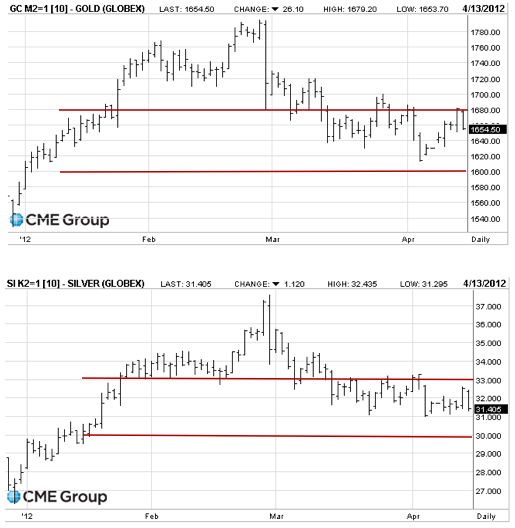Gold and Silver Wait Patiently for More Easing
Commodities / Gold and Silver 2012 Apr 14, 2012 - 08:03 AM GMTBy: Eric_McWhinnie
After having a strong performance the prior day, the markets experienced a broad pullback as growth data from China disappointed investors. Gold prices fell more than 1.5 percent, while silver dropped 3.3 percent.
On Friday, the National Bureau of Statistics in Beijing announced that China’s economy grew at 8.1 percent in the first quarter of 2012, its slowest pace in about three years. Economists were expecting growth of about 8.3 percent and the whisper number was around 9 percent. In comparison, China grew at 8.9 percent in the previous quarter, and 11.9 percent in the first quarter of 2010. Song Yu, China economist at Goldman Sachs explained, “Growth in the first two months was weak. We had some loosening of monetary and fiscal policy in March, but it wasn’t enough to save the quarterly number,” according to the WSJ.
As the charts show below, gold continues to meet resistance at $1,680 per ounce and declined to $1,655 on Friday. Meanwhile, silver has resistance at $32.50-$33 per ounce and fell to $31.40. Both precious metals have remained in a tight trading range as monetary easing expectations continue to fluctuate in media headlines.

While the slowdown in China may provide more room for easing in the world’s second largest economy, economists and investors appear to be torn about more monetary easing in the United States. According to a recent survey of economists by the WSJ, 36 out of 51 economists polled believed the Federal Reserve will not take further action, such as another round of quantitative easing. Growth is still providing economists with enough hope to remain optimistic. The report explained, “On average, economists estimate that gross domestic product grew a respectable, if not particularly strong, 2.2 percent in the first quarter. They forecast growth to accelerate throughout 2012 to a 2.7 percent quarter-over-quarter annualized rate by the end of the year.”
However, central bank bond purchases and record low induced interest rates are the current foundation of the “recovery.” Recent reports indicate that the Federal Reserve purchased 61 percent of the government debt issued by the Treasury Department in 2011. Since 2008, The Fed has purchased more than $2 trillion of bonds in two rounds of quantitative easing.
Despite what economists predict, investors are less confident that the Fed will restrain from further bond purchases in order to prop up the economy. According to a Citigroup survey released on Thursday, almost 45 percent of respondents said they did not expect the Fed to initiate more quantitative easing, down from 60 percent a month earlier. “The data has been a bit softer, especially the recent payrolls number,” said Neela Gollapudi, a New York-based strategist at Citigroup, according to Bloomberg. “The strength of conviction that there was going to be no more QE at all would be less now than when it was in March, when everything seemed to be going very well.”
Surveys continue to debate whether or not the Fed will provide additional easing, but gold and silver, the time tested safe-havens of the world, wait patiently as the inevitable devaluation of fiat currencies take place around the world.
For more analysis on our support levels and ranges for gold and silver, consider a free 14-day trial to our acclaimed Gold & Silver Investment Newsletter.
By Eric_McWhinnie
Wall St. Cheat Sheet : Only days after the S&P 500 crashed to the depths of hell at 666, the Hoffman brothers launched Wall St. Cheat Sheet: one of the fastest growing financial media sites on the web. Like a samurai, our mission is to cut through the bull and bear shit with extraordinary insights, a fresh voice, and razor-sharp wit. We provide the highest quality education and information for active investors, financial professionals, and entrepreneurs.
© 2012 Copyright Eric McWhinnie - All Rights Reserved
Disclaimer: The above is a matter of opinion provided for general information purposes only and is not intended as investment advice. Information and analysis above are derived from sources and utilising methods believed to be reliable, but we cannot accept responsibility for any losses you may incur as a result of this analysis. Individuals should consult with their personal financial advisors.
© 2005-2022 http://www.MarketOracle.co.uk - The Market Oracle is a FREE Daily Financial Markets Analysis & Forecasting online publication.



